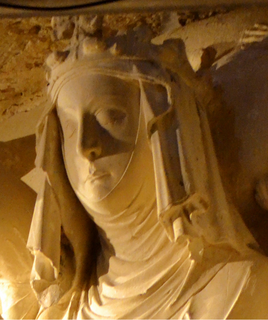 W
WThe Capetian House of Anjou was a royal house and cadet branch of the direct French House of Capet, part of the Capetian dynasty. It is one of three separate royal houses referred to as Angevin, meaning "from Anjou" in France. Founded by Charles I of Anjou, the youngest son of Louis VIII of France, the Capetian king first ruled the Kingdom of Sicily during the 13th century. Later the War of the Sicilian Vespers forced him out of the island of Sicily, leaving him with the southern half of the Italian Peninsula — the Kingdom of Naples. The house and its various branches would go on to influence much of the history of Southern and Central Europe during the Middle Ages, until becoming defunct in 1435.
 W
WBlanche of Anjou was Queen of Aragon as the second spouse of King James II. She was a member of the Capetian House of Anjou, she is also known as Blanche of Naples. She served as Regent or "Queen-Lieutenant" of Aragon during the absence of her spouse in 1310.
 W
WCharles I, commonly called Charles of Anjou, was a member of the royal Capetian dynasty and the founder of the second House of Anjou. He was Count of Provence (1246–85) and Forcalquier in the Holy Roman Empire, Count of Anjou and Maine (1246–85) in France; he was also King of Sicily (1266–85) and Prince of Achaea (1278–85). In 1272, he was proclaimed King of Albania; and in 1277 he purchased a claim to the Kingdom of Jerusalem.
 W
WEleanor of Anjou was Queen of Sicily as the wife of King Frederick III of Sicily. She was a member of the Capetian House of Anjou by birth.
 W
WElisabeth of Sicily (1309–1349) was a daughter of Frederick III of Sicily and Eleanor of Anjou. Her siblings included: Peter II of Sicily and Manfred of Athens. After her death her title was given to Georgia Lanza.
 W
WHelen of Anjou was the queen consort of the Serbia, as spouse of King Stefan Uroš I, who ruled from 1243 to 1276. Their sons were later Serbian kings Stefan Dragutin (1276-1282) and Stefan Milutin (1282-1321). As a dowager-queen, she held provincial governorship in the regions of Zeta and Travunija. She built Gradac monastery and was known for her religious tolerance. She is revered as saint by the Serbian Orthodox Church.
 W
WLouis of Toulouse was a Neapolitan prince of the Capetian House of Anjou and a Catholic bishop.
 W
WMargaret, Countess of Anjou was Countess of Anjou and Maine in her own right and Countess of Valois, Alençon, Chartres and Perche by marriage. Margaret's father was King Charles II of Naples, whilst her husband was Charles of Valois, and her older brother was Saint Louis of Toulouse; her nephew was Charles I of Hungary.
 W
WMary of Hungary, of the Árpád dynasty, was Queen consort of the Kingdom of Naples. She was a daughter of Stephen V of Hungary and his wife Elizabeth the Cuman. Mary served as Regent in Provence in 1290–1294 and in Naples in 1295–96, 1296–98, and 1302, during the absences of her consort.
 W
WMaria of Anjou was a member of the Capetian House of Anjou who served as Queen of Majorca during her marriage to King Sancho. She was the daughter of Charles II of Naples and his wife, Maria of Hungary.
 W
WRobert of Anjou, known as Robert the Wise, was King of Naples, titular King of Jerusalem and Count of Provence and Forcalquier from 1309 to 1343, the central figure of Italian politics of his time. He was the third son of King Charles II of Naples and Maria of Hungary, and during his father's lifetime he was styled Duke of Calabria (1296–1309).
 W
WRaymond Berengar was the count of Andria and possibly Count of Provence and Prince of Piedmont.
 W
W